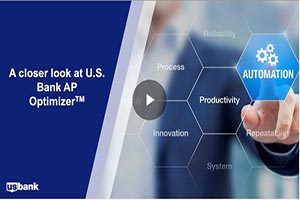Emerging new channels and use cases
Here's a look at some of the new payment channels that U.S. companies are adding to the mix and the use cases making it worthwhile:
Virtual card: An increasingly common strategy is replacing checks with single-use virtual card payments, where possible. Migrating payments to virtual card can reduce check payment costs and, in many cases, provide payers with revenue share. The virtual card channel is easy to set up and doesn’t require any IT resources. Banks can take the payment instructions file the payer was sending them for check issuance and try to migrate to virtual card those vendors in the file known to accept card payments.
Zelle: The Zelle® digital payment network allows individuals and businesses to send and receive money in near real time using a mobile phone number or email address. Making business-to-consumer (B2C) payments with Zelle allows companies to eliminate the costs of printing and mailing checks, as well as avoid the risks associated with collecting and storing payee bank account information when making ACH payments. Zelle B2C uses include refunds, such as utility refunds to homeowners; rebates; insurance claim payments; incentive payouts; employee payouts; and gig worker payments.
Zelle is gaining traction as a payment alternative in higher education, Haber notes. “Zelle is a great option for issuing students convenient refunds when they drop classes, for instance,” he says. “In addition, Zelle serves as a great way to support payments to students after they graduate, when checks often can’t be delivered and cashed due to outdated addresses.”
Push to card (aka “push to debit”): This is another new option for making payments to consumers without requiring them to provide bank account information. The push-to-card channel takes advantage of the fact that most consumers carry a debit card. Companies can use the debit card payment rails to initiate real-time B2C payments — essentially reverse debit card payments — that can support a variety of use cases.
For instance, Haber says push to card is ideal for insurers paying consumer claims following a natural disaster. Push to card can provide the immediate funds insureds need to recover and overcomes the obstacle of delivering those funds to people who may have left their homes. “Where it may be impossible to deliver a check or prepaid card by mail to an insured, push to card affords digital, near real-time delivery,” Haber says.
Instant payments via the RTP® network and FedNow® Service: Perhaps the most exciting development in the payment space, the RTP® network and recently-launched FedNow® Service are 24/7 payment rails that provides instant settlement of funds, enabling companies to send, receive and request payments for many use cases, including e-invoicing and e-billing. That provides payment certainty — every payment is final, irrevocable and confirmed in near real-time — and rich flexible messaging. RTP can be used for business-to-business payments such as merchant funding and settlement, loan/lease funding and payment on delivery; B2C transactions such as payroll, title and escrow payments, and insurance claim payments; and a wide range of consumer-to-business (C2B) payments.
One emerging B2C use for RTP is making payroll corrections. In the event there is an issue with an employee’s pay, RTP allows a business to make a real-time correction. “Today, with such an acute focus on employee satisfaction, that’s a huge win,” Haber says.
On the C2B front, RTP allows a biller to send a request for payment (RfP) message to a recipient, who can evaluate the request along with related invoice details to approve or deny payment. RfPs provide consumers flexibility and convenience in paying their bills and certainty that the payment has cleared instantly. RfP use cases include online bill pay transactions, loan/lease payoffs and traditional debt payments.




































































